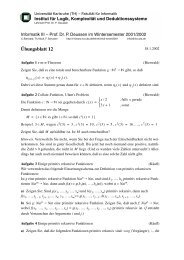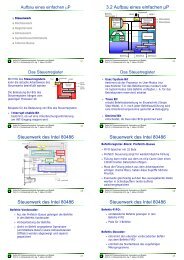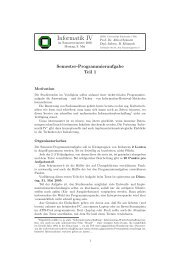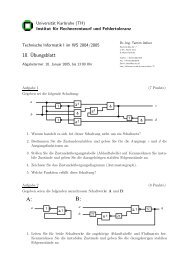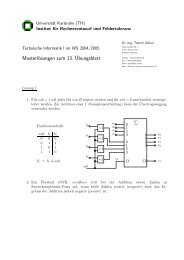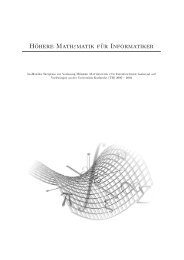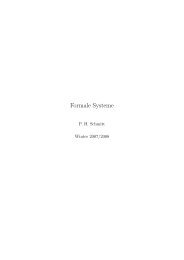Nachname/Last name Vorname/First name ... - next-internet.com
Nachname/Last name Vorname/First name ... - next-internet.com
Nachname/Last name Vorname/First name ... - next-internet.com
Sie wollen auch ein ePaper? Erhöhen Sie die Reichweite Ihrer Titel.
YUMPU macht aus Druck-PDFs automatisch weboptimierte ePaper, die Google liebt.
1<br />
<strong>Nach<strong>name</strong></strong>/<strong>Last</strong> <strong>name</strong> Vor<strong>name</strong>/<strong>First</strong> <strong>name</strong> Matrikelnummer/<br />
Matriculation number<br />
Musterfrau Marlene 999999<br />
Aufgabe/Question 1 (Zum Aufwärmen/Warm up, 3+3+1+…+1Punkte/marks)<br />
1. „Zählen Sie drei gebräuchlichen Kriterien auf, auf welche sich praktikable Seitenersetzungsverfahren<br />
(page replacement) abstützen, und geben Sie jeweils ein konkretes Verfahren an!“<br />
“Enumerate the three <strong>com</strong>monly used criteria being used by practical page replacement<br />
algorithms, and give a concrete example for each of these algorithms.”<br />
a) Einlagerungszeitpunkt der Seite für FIFO<br />
Timestamp of swap-in for FIFO<br />
b) Zeitpunkt des letzten Seitenzugriffs für LRU<br />
Time of last reference on that page for LRU<br />
c) Anzahl der Referenzen pro Seite für LFU<br />
Number of references on that page fpr LFU<br />
2. „Zählen Sie drei typische Kernschnittstellenoperationen (kernel interface function) auf!“<br />
“Enumerate at least three typical kernel interface functions.”<br />
a) Sende_Nachricht()<br />
Send_Message()<br />
b) Erzeuge_Thread()<br />
Create_Thead()<br />
c) Yield()<br />
Yield()<br />
Einige der folgenden Aussagen sind korrekt, einige inkorrekt. Unterstreichen Sie „korrekt“, wenn<br />
die Aussage korrekt ist, unterstreichen Sie „inkorrekt“, wenn die Aussage inkorrekt ist.<br />
Some of the following statements are correct, some are incorrect. Underline “korrekt” if the<br />
statement is correct; underline “inkorrekt” if the statement is incorrect!<br />
3. „In einem Einprozessorsystem, in dem bis zu 1000 Threads gleichzeitig aktiviert sind, ist es<br />
effizienter, den Threadzustand „bereit“ (ready) durch eine explizite Datenstruktur zu<br />
implementieren als nur durch ein entsprechendes TCB-Attribut.“<br />
“In a single-processor system with up to 1000 currently activated threads, it is more efficient<br />
to implement the thread-state “ready” by a separate data structure than by a corresponding<br />
TCB attribute.”<br />
korrekt inkorrekt
2<br />
Fortsetzung von Aufgabe 1 / Question 1 continued: (1+1+1+1+1 Punkte/marks)<br />
4. „Beim Speicherbereinigungsverfahren (garbage collection) werden belegte Stücke so<br />
lange verschoben, bis ein genügend großes Speicherstück frei geworden ist, mit dem die<br />
aktuelle Speicheranfrage erfüllt werden kann.<br />
“The garbage collection algorithm shifts allocated memory regions until there is a free<br />
memory region large enough to satisfy the current storage request.”<br />
korrekt inkorrekt<br />
5. „Das strikte Zwei-Phasen Protokoll kann zu Verklemmungen (deadlocks)führen.“<br />
“The strict two-phase protocol may lead to deadlocks.”<br />
korrekt inkorrekt<br />
6. „Unter allen nicht verdrängenden Schedulingverfahren ist SJF (shortest job first) optimal<br />
bezüglich der mittleren Bearbeitungszeit (turnaround-time).“<br />
“When only considering non-preemptive scheduling algorithms, SJF (shortest job first) is<br />
optimal with respect to the average turnaound-time.”<br />
korrekt inkorrekt<br />
7. „Semaphore sind ein komfortables und robustes Mittel, um auf Appliktionsebene wechselseitigen<br />
Ausschluß (mutual exclusion) zu etablieren.“<br />
“Semaphores are a <strong>com</strong>fortable and robust tool to esrablish mutual exclusion at application<br />
level.”<br />
korrekt inkorrekt<br />
8. „Nebenläufige (concurrent) Threads treten nur in Einprozessorsystemen auf.“<br />
“Concurrent threads only occur within single-processor systems.”<br />
korrekt inkorrekt
3<br />
<strong>Nach<strong>name</strong></strong>/<strong>Last</strong> <strong>name</strong> Vor<strong>name</strong>/<strong>First</strong> <strong>name</strong> Matrikelnummer/<br />
Matriculation number<br />
Musterfrau Marlene 999999<br />
Aufgabe/Question 2 (6 +4+2 Punkte/marks)<br />
1. „Geben Sie in folgender Programmskizze eine Implementierung für eine generalisierte<br />
Synchronisation für n Threads an! Gehen Sie davon aus, daß die Schnittstellenoperation<br />
n_synchronize atomar ist.“<br />
“Implement in the following program template a generalized synchronization module to<br />
synchronize n threads. Assume that the interface operation n_synchronize is atomic.”<br />
module generalized synchronization<br />
export n_synchronize<br />
import UnblockThread, BlockThread<br />
type n_sync = record<br />
NUMBER: integer = n; {# allowed threads}<br />
COUNT: integer := 0; {# current waiting threads}<br />
SWT: waiting thread := empty {waiting queue}<br />
end<br />
procedure n_synchronize(SY:n_sync)<br />
begin<br />
SY.COUNT := SY.Count + 1;<br />
if SY.COUNT < SY.NUMBER<br />
then begin {I am not the last thread}<br />
BlockThread(SY.SWT) {wait for my partner}<br />
end<br />
else begin {I am the last thread and must}<br />
while SY.SWT != empty do<br />
UnblockThread(SY.WT);{release my partners}<br />
SY.COUNT := 0; {resetting for reuse}<br />
end<br />
end<br />
end module<br />
{queuing and dequeing will be done within BlockThread and UnblockThread}
4<br />
Fortsetzung von Aufgabe 2 / Question 2 continued: (4+2Punkte/marks)<br />
2. „Geben Sie in Form einer knappen Programmskizze ein Anwendungsbeispiel für obiges<br />
generalisierte Synchronisationsmodul an!“<br />
“Try to illustrate in a brief program template an example for an application of the above<br />
generalized synchronization module.”<br />
{some numerical problem solved via difference<br />
equations}<br />
.<br />
.<br />
while true do<br />
begin<br />
for all i,j<br />
begin<br />
temp[i,j] := old[i-1,j] + old[i+1,j]<br />
end<br />
n_synchronize(S)<br />
for all i,j<br />
begin<br />
old[i,j] := temp[i,j]<br />
end<br />
n_synchronize(S)<br />
end<br />
.<br />
.<br />
3. „Welche Hardwareunterstützung würden Sie verwenden, um ein atomares<br />
n_synchronize in einem Ein- bzw. Mehrprozessorsystem zu implementieren?“<br />
“Which hardware support would you use to implement an atomic n_synchronize in a<br />
single- and in a multi-processor system?”<br />
Single-processor system:<br />
Disable_Interrupt and Enable_Interrupt<br />
Multi-processor system:<br />
Spin_Lock with a TEST_AND_SET instruction
5<br />
<strong>Nach<strong>name</strong></strong>/<strong>Last</strong> <strong>name</strong> Vor<strong>name</strong>/<strong>First</strong> <strong>name</strong> Matrikelnummer/<br />
Matriculation number<br />
Musterfrau Marlene 999999<br />
Aufgabe 3 / Question 3 : (5 +3+2+2Punkte/marks)<br />
1. „Analysieren Sie die folgende Pogrammskizze, ob dadurch alle Anforderungsbedingungen<br />
für einen korrekten wechselseitigen Ausschluß auf Applikationsebene erfüllt werden!“<br />
“Analyze whether the following program draft fulfills all requirements for correct mutual<br />
exclusion at application level.”<br />
2.<br />
Process 0 Process 1<br />
. .<br />
. .<br />
. .<br />
flag[0] := true; flag[1] := true;<br />
while flag[1] do while flag[0] do<br />
begin begin<br />
flag[0] := false; flag[0] := false;<br />
{ delay for a while } { delay for a while }<br />
flag[0] := true flag[1] := true<br />
end; end;<br />
{ critical section } { critical section }<br />
flag[0] := false; flag[1] := false;<br />
. .<br />
. .<br />
.<br />
.<br />
Obiger Vorschlag kommt einer korrekten Lösung recht nahe, aber bei ungünstigen<br />
Zeitverhältnissenkanneszufortwährendem Warten beider Threads vor<br />
dem kritischen Abschnitt kommen. Somit verletzt diese „Scheinlösung“ eine<br />
wesentliche Anforderung nach einer begrenzten Wartezeit (bounded waiting) vor<br />
dem kritischen Abschnitt und ist somit unbrauchbar. Die anderen<br />
Anforderungen wären dagegen erfüllt.<br />
This proposal is close to a solution, but it is still flawed. With certain timing<br />
conditions both threads may wait indefinitely in front of their critical sections. Thus<br />
in the above approach there is no bounded waiting in front of a critical section, so<br />
we can’t use it. However, the other requirements are fulfilled.
6<br />
Fortsetzung von Aufgabe 3 / Question 3 continued: (3 + 2+ 2 Punkte/marks)<br />
3. „„Gegeben seien zwei nebenläufige Transaktionen T1 und T2, von denen jede aus eine Reihe<br />
von Lese- bzw. Schreiboperationen auf eine gemeinsame Datenbank aufgebaut sei. Die<br />
Datenbank bestehe aus d>>1 Datenobjekten doi, von denen jedes separat durch einen<br />
Read_Lock bzw. Write_Lock vor gleichzeitigem Zugriff geschützt werden kann. Welche<br />
Bedingungen müssen gegeben sein, damit obige Transaktionen im Konflikt stehen?”<br />
“Assume there are two concurrent transactions T1 and T2 each of which consists of a<br />
sequence of read- and write-operations to a shared database. This database consists of d>>1<br />
data objects each of which can be protected against concurrent accesses by a separate<br />
Read_Lock and/or by a separate Write_Lock. Which conditions may lead to conflicting<br />
transactions?”<br />
There is a data object doI being accessed by both Transactions T1 und T2<br />
At least one of them, e.g. T1 does a write operation on this data object doI.<br />
If the other transaction T2 does an additional operation on this data object<br />
-either another write or a read- then both transaction are conflicting.<br />
4. „Welche der vier Eigenschaften des ACID-Prinzips wird durch einen serialisierbaren<br />
(serializable) Ablaufplan herbeigeführt?“<br />
“Which of the four requirements of the ACID-principle is achieved by a serializable<br />
schedule? ”<br />
Isolation<br />
5. „Was sind die Vor- und Nachteile, wenn in einer gemeinsamen Datenbank jedes Datenobjekt<br />
separate Sperren (locks) besitzt?<br />
“What are the pros and cons of having separate locks per data object in a shared data<br />
base?”<br />
Pros: Additional concurrency may lead to a better throughput, you are only<br />
locking regions of the data base you really need<br />
Cons: Increased overhead for locking and relasing (+ additional space for all<br />
these locks)<br />
Increased danger for deadlocks
7<br />
<strong>Nach<strong>name</strong></strong>/<strong>Last</strong> <strong>name</strong> Vor<strong>name</strong>/<strong>First</strong> <strong>name</strong> Matrikelnummer/<br />
Matriculation number<br />
Musterfrau Marlene 999999<br />
Aufgabe/Question 4 (4+2+2+4Punkte/marks)<br />
1. „ In einem System mit virtuellem, seitenorientierten Speicher ist ein Seitenfehler (page-fault)<br />
aufgetreten. Welche Systemaktivitäten, die zur Beseitigung des Seitenfehlers notwendig sind,<br />
werden dabei innerhalb und welche werden außerhalb der Unterbrechungsbehandlungsroutine<br />
ausgeführt? Geben Sie eine kurze Begründung für Ihre Wahl!“<br />
“A page-fault has occured in a system with paged virtual memory. Which of the system<br />
activities necessary to handle this page-fault will be executed within the page-fault interrupt<br />
handler, and which will be executed outside of this interrupt handler. Give a short<br />
explanation for your choice.”<br />
Seitenfehlerbehandler:<br />
Festhalten, welcher Thread den Seitenfehler produziert hat<br />
Benachrichtigen des Seitenersetzer (pager)<br />
Seitenersetzer:<br />
Kachel zum Beheben des Seitenfehlers gemäß der Ersetzungsstrategie besorgen<br />
(u.U. 2 mal den Plattentreiber aufrufen für’s Ein- bzw. Auslagern der alten bzw.<br />
neuen Seite)<br />
Page fault handler:<br />
Save the thread-id of the thread issuing the page-fault<br />
Send an appropriate page-fault message to the pager<br />
Pager:<br />
Get a page-fame to handle the page-fault according to a paging policy<br />
(i.e. this pager might invoke two times the disk driver to swap out the old page<br />
respectively to swap in the new one)<br />
2. „Wieviel Bytes benötigt eine flache Seitentabelle in einem System mit 32-bit logischen<br />
Adressen, einem Seitentabelleneintrag von 4 Bytes und einer Seitengröße von1KB?“<br />
“How many bytes would a flat page table need in a system with 32-bit logical addresses, a<br />
page entry size of 4 bytes, and a 1 KB page size?”<br />
Seitentabellengröße in bytes/Page table size in bytes:16MB
8<br />
Fortsetzung von Aufgabe 4 / Question 4 continued: (2+4Punkte/marks)<br />
3. „ Gegeben sei ein Seitenreferenzstring für einen Applikationsthread mit einer<br />
Hauptspeichermenge (resident set) von m Kacheln, die initial alle leer seien. Der<br />
Seitenreferenzstring habe die Länge p, wobei n verschiedene Seitennummern enthalten sind.<br />
Wie lauten für jeden Seitenersetzungsalgorithmus<br />
a) dieuntereSchrankefür die Seitenfehleranzahl,<br />
b) die obere Schranke für die Seitenfehleranzahl?“<br />
“Consider a page reference string for an application thread with a resident set of m frames,<br />
initially all empty. The page reference string is of length p with n distinct page numbers in it.<br />
For any page replacement algorithm,<br />
a) what is the lower bound on the number of page faults and<br />
b) what is the upper bound on the number of page faults.”<br />
a) n<br />
b) p<br />
4. „Skizzieren oder beschreiben Sie die Wirkungsweise vonn Copy on Write! In welchem<br />
Zusammenhang wird Copy on Write eingesetzt?“<br />
“Describe the method Copy on Write. In which content Copy on Write is used?”<br />
Copy on Write erlaubt es, daß Threads aus verschiedenen Adreßräumen Daten<br />
möglichst platzsparend gemeinsam sowohl lesend als auch schreibend nutzen<br />
können. Der erste Thread, der auf diese gemeinsamen Daten modifizierend<br />
zugreifen möchte, erhält eine private Kopie der entsprechenden Datenseite(des<br />
Datensegments).<br />
Copy on write enables that threads of different address spaces may use <strong>com</strong>mon<br />
data (read or write) without wasting main memory. The first thraed trying to write<br />
on these <strong>com</strong>mon data will get a private copy of the corresponding data page (or<br />
segment)
9<br />
<strong>Nach<strong>name</strong></strong>/<strong>Last</strong> <strong>name</strong> Vor<strong>name</strong>/<strong>First</strong> <strong>name</strong> Matrikelnummer/<br />
Matriculation number<br />
Musterfrau Marlene 999999<br />
Aufgabe 5/ Question 5: (7 +5Punkte/marks)<br />
1. „Beschreiben Sie so ausführlich wie nötig, aber dennoch so knapp wie möglich, was ein<br />
Mikrokern ist und welche Vor- und Nachteile mit einer Mikrokernarchitektur verknüpft<br />
sind!“<br />
“Describe as detailed as necessary, but nevertheless as short as possible what a micro-kernel<br />
is and which advantages and disadvantages are connected with a micro-kernel based<br />
architecture.”<br />
Ein Mikrokern sollte nur die absolut wichtigen Basisfunktionen eines<br />
Betriebssystems enthalten, die eh im privilegierten Prozessormodus ausgeführt<br />
werden müssen bzw. die so essentiell sind, daß ohne sie ein System überhaupt<br />
nicht organisiert werden kann. Hierzu zählen zum einen Funktionen, die zur<br />
Etablierung und zur Kontrolle von Threads und Adreßräumen beitragen, u.a.<br />
create_thread(), create_address_space(), schedule_thread() etc.<br />
Damit Threads (im allg. aus verschiedenen Adreßräumen) miteinander<br />
interagieren können, indem sie z.B. Nachrichten austauschen, oder sich an<br />
kritischen Abschnitten synchronisieren, müssen vom Mikrokern geeignete, d.h.<br />
insbesondere schnelle Interaktionsoperationen (IPCs) angeboten werden.<br />
Alle sonstigen Systemfunktionen werden als Dienste (server) implementiert, die<br />
wie jede Applikation im Benutzermodus ablaufen. Ob jeder Dienst in einem<br />
eigenem Adreßraum ablaufen muß, ist eine Entscheidung, die vom<br />
Mikrokernansatz unabhängig ist, aber sehr wohl die Leistungsfähigkeit des<br />
Systems entscheidend prägt. Insbesondere an die Effizienz der IPC-Operationen<br />
werden Ansprüche gestellt, denn wenn dieser Serveransatz überhaupt<br />
praktikabel sein soll, müssen die Funktionen zum Interagieren zwischen<br />
Anwendungs- und/oder Serverthreads extrem schnell sein. Bei den heutigen<br />
Rechnerarchitekturen mit ein- bis mehrstufigen Caches muß deswegen der<br />
Mikrokern auch so klein wie möglich sein, damit seine IPC-Funktionen schnell<br />
sein können, da der Mikrokern ansonsten den Applikationen zuviel Platz im<br />
Cache wegnimmt bzw. zu viele Cachemisses auftreten können.<br />
Der Mikrokernansatz ermöglicht Systemarchitekturen, welche unterschiedliche<br />
Varianten eines Dienstes anbieten können, so daß somit flexibel auf neue<br />
Hardwarefähigkeiten bzw. bisher nicht unterstützbare Applikationen reagiert<br />
werden kann. Ferner kann man damit robustere System erstellen, da sich im<br />
Gegensatz zu monolithischen Systemen Fehler eines neuen Dienstes nur<br />
innerhalb dieses Dienstes auswirken können.
10<br />
Fortsetzung von Aufgabe 5 / Question 5 continued: ( 5 Punkte/marks)<br />
2. „Gegeben sei ein symmetrisches Multiprozessorsystem (SMP) aus 4 Prozessoren, die alle<br />
über den Systembus an den gemeinsamen Hauptspeicher (main memory) angeschlossen sind.<br />
Pro Prozessor existiere ein L1- und ein L2-Pufferspeicher (cache).<br />
Auf Prozessor ZP4 läuft ein Schachprogramm mit einer großen Arbeitsmenge (working set),<br />
die nicht vollständig in den L2-Cache paßt. Dieses Schachprogramm läuft unabhängig von<br />
allen sonstigen Anwendungen. Drei kooperierende Threads mit jeweils mittelgroßer<br />
Arbeitsmenge (working set), d.h. jede von ihnen paßt vollständig in einen L2-Cache, laufen<br />
echt parallel auf den Prozessoren ZP1 bis ZP3. Diese drei kooperierenden Threads<br />
synchronisieren sich mittels des unten skizzierten „Spinlocks“:<br />
Warum läuft das Schachprogramm deutlich langsamer als auf einem Einprozessorsystem?“<br />
“Given a symmetric multi-processors system (SMP) consisting of 4 processors operating on a<br />
<strong>com</strong>mon main memory via a system-bus. L1 and L2 caches exist per processor.<br />
Processor ZP4 executes a chess program with a large working set that in general does not fit<br />
into its L2 cache. This chess program runs independently of all other applications. Three<br />
cooperating threads with medium sized working sets, i.e. each working set fits into an L2cache<br />
run in parallel on processors ZP1 through ZP3. The three cooperating threads<br />
synchronize with each other by means of the following spinlock:<br />
Why does the chess program run substantially slower than on a single-processor system?”<br />
DO<br />
reg := MyThreadId ;<br />
xchg (SpinLock,reg) {special atomic exchange operation}<br />
{exchanges mem/cache variable SpinLock and reg}<br />
UNTIL reg = 0 OD;<br />
...<br />
... critical section ...<br />
...<br />
SpinLock := 0<br />
{SpinLock = 1 ⇔ another Thread is in its critical section}<br />
{SpinLock = 0 ⇔ critical section is free }<br />
Only one of the three cooperating threads may be in its critical section holding the spin<br />
lock SpinLock. The other two threads meanwhile have to <strong>com</strong>pete for acquiring this<br />
spin lock. Because both <strong>com</strong>peting threads are reading and writing the variable<br />
SpinLock, the contents of SpinLock will be ping-ponged between their related caches,<br />
accessing the variable SpinLock in main memory, too. This will generate lots of bus<br />
traffic, causing other memory intensive programs in the system to run slower. Due to<br />
its large working set the chess program is quite memory intensive.




